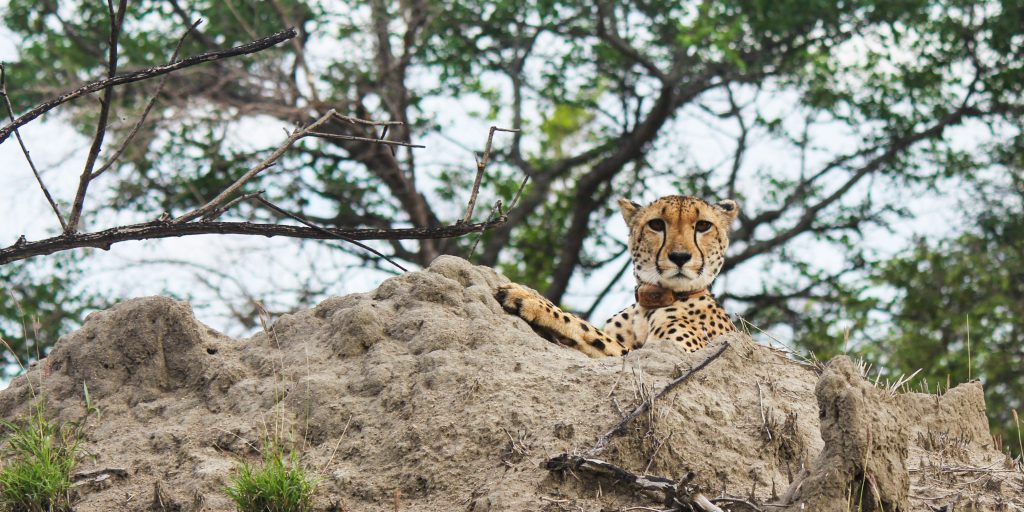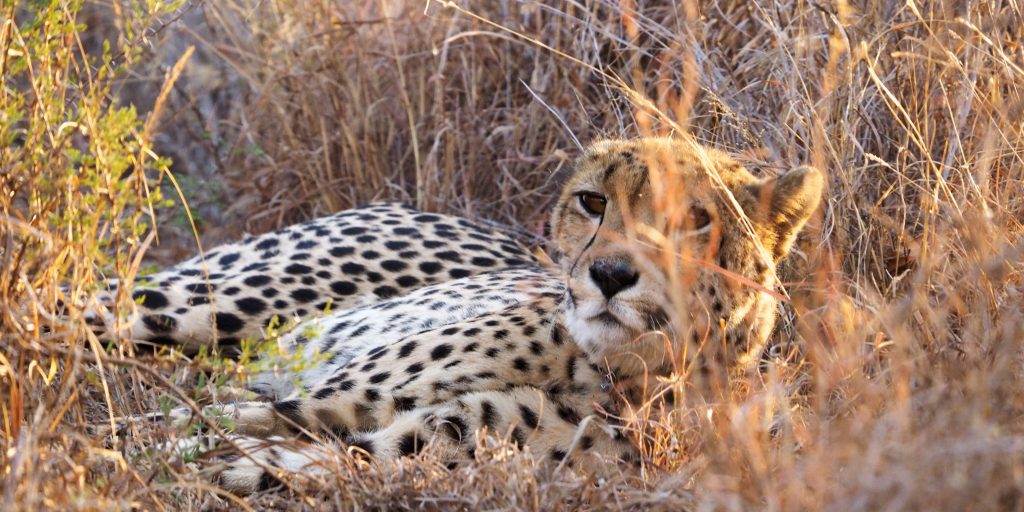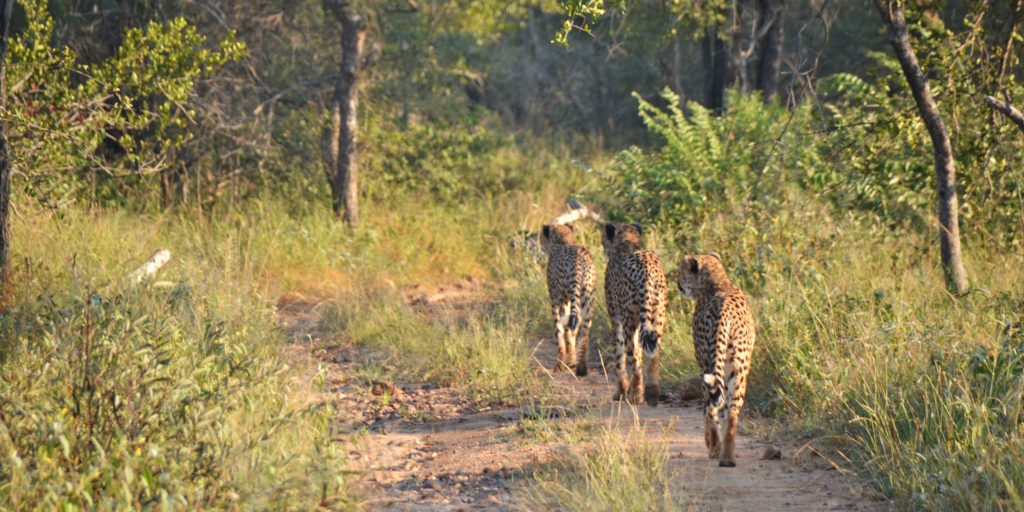Discover how Namib Desert wildlife thrives in extreme conditions – elephants, beetles, plants & more adapt uniquely to survive harsh environments.
GVI
Posted: July 9, 2024

Zaytoen Domingo
Posted: April 1, 2019
The female cheetah’s ears rotate slowly, listening. Her lithe body is hidden by the trees she’s in. Her whiskers are pointed forward. She’s anxious. A lion pride is in the grassland in front of her. She skirts around them, staying hidden in the trees.
She has good reason to stay hidden. Her brothers and sisters were killed when she was little by resident lions, a typical interaction between these two big cats. Lions also steal her kills.
She’s vigilant for other African predators, like leopards, hyenas and African wild dogs, who call the Karongwe Private Game Reserve (Karongwe) home.
GVI’s wildlife conservation projects in South Africa, big cat conservation research and cheetah conservation and research, are showing that cheetahs are survivors. This is despite intense competition from other big cats like lions and leopards, and hyenas, and the threats cheetahs already face.
How are cheetahs managing to compete, despite their smaller bodies and lower strength than other big cats and African predators like hyenas?
Why is it important to know how cheetahs cope with this competition? And is this competition driving cheetah numbers down further? Let’s investigate some of these questions.

Our female cheetah is one of 340 of a heavily-managed population of cheetahs in small fenced South African reserves. She isn’t one of the estimated 6,674 free-ranging mature individuals left globally in the wild.
The International Union for the Conservation of Nature (IUCN) lists the cheetah as vulnerable.
Two years after the IUCN’s assessment, researchers gathered to discuss the rapid decline of free-ranging cheetahs. Their report argues for cheetahs to be upgraded to endangered status.
If the IUCN upgrades their status to endangered, it will inform government’s decision-making processes around conservation planning. It will also help private organisations guide investment decisions, as they often invest in the protection of endangered species.

Our female cheetah is lucky she is in a private reserve. Her grassland and savannah home won’t disappear or become fragmented due to development.
She won’t face retaliatory killing for doing what she does naturally – hunting. Cheetahs outside fenced reserves sometimes hunt livestock when their wild prey levels reduce and are subsequently killed by farmers.
Why is our female cheetah part of a managed population in fenced reserves? Up until 2009, cheetahs on farmland where there was human-predator conflict were relocated into fenced reserves. This no longer happens, as a better long-term solution is giving farmers livestock guarding dogs.
Now, one of our partners who we collaborate with, the Cheetah Metapopulation project, is managing this cheetah population to ensure its long-term viability.

As Karongwe is a private reserve, prey levels are carefully managed. Our female cheetah won’t go hungry because her prey has been over-hunted or harvested for bushmeat.
She won’t be captured for illegal trade either. Cheetahs outside fenced reserves aren’t so lucky. Rising demand in the Gulf States for cheetahs as luxury pets means many mothers and cubs are caught and traded. Two-thirds of these cubs die en route.
Because of these threats, cheetahs now only occupy 9% of their original home range.
How are cheetahs facing down other big cats and African predators?

Our female cheetah eats very quickly. She never knows when other big cats or predators like lions, leopards or scavenging hyenas may take her kill. She remembers how her mum used to stand watch while she ate as a cub, so she could have her fill.
Up to one in eight cheetah kills can be stolen by other big cats and African predators like hyenas. Unlike leopards, cheetahs lack the strength to drag their prey up a tree, and they don’t have the body power to take on lions or hyenas.
There is a perception that competition with other big cats and African predators suppresses cheetah populations. However, research is showing adult cheetahs eating quickly, and female cheetahs standing watch as their cubs eat. This maximises their chances of getting a good feed before it is snatched away.

If cheetah kills are frequently stolen, is the extra effort spent hunting compromising their individual survival? Not necessarily. Data our volunteers collect on our cheetah conservation and research project helps us determine how much extra effort cheetahs put in.
Our research finds that cheetahs can actually cope with up to 25% of their kills being stolen. Cheetahs only need to spend about an extra hour per day searching for prey, to offset their stolen kills.
In fact, this research shows that cheetahs spend more energy on travelling than hunting. If cheetahs are forced to travel long distances to avoid disturbance and persecution from humans, this may push individual cheetahs to their survival limit.

Our female cheetah is tense. She has detected that another big cat, a leopard, was recently where she is now. After some time, she relaxes and moves out of the area to continue her hunt and avoid potential competition.
Data we collect on our female cheetah’s fine-scale movements through tracking shows that she does a delicate dance that makes her a master at avoiding other big cats and predators. She coexists with lions, unlike African wild dogs. She does this by staying in shrubland habitat that lions rarely use and by hunting during the day, as lions mainly hunt at night.
Interestingly, by staying within lion territory she’s reducing her competition with African wild dogs, as their territories don’t tend to overlap with lions.
This means competition with other predators isn’t further endangering cheetah populations, as originally thought. Instead, it shows cheetahs are survivalists due to their behavioural adaptations to this competition.
This tells us we need to focus cheetah conservation efforts on human threats, rather than managing their interactions with Africa’s other big cats and large predators.

All of GVI’s programs have short, medium and long-term goals. In the case of the cheetah conservation and research project, GVI’s research directly contributes to Goal 15 of the United Nations Sustainable Development Goals (UN SDGs), life on land. This means our work is designed to have a lasting impact.
For example, our volunteers are gathering data on the breeding success of cheetahs in Karongwe, to support the Cheetah Metapopulation project. This project is managing cheetah genetic diversity throughout Southern Africa, in both private and national parks. Individual cheetahs are translocated into different reserves to ensure new genes are introduced and less inbreeding occurs.
In the case of Karongwe, three male cheetahs, Kwa, Zulu and Natal were introduced in 2017. Our volunteers are documenting any breeding events witnessed with our female cheetah, and following the survival of cheetah cubs born.

There are many ways you can help with cheetah conservation. You can:

Our female cheetah is walking purposefully and confidently along the vehicle track, her eyes continually scanning, ears rotating, always listening. She is hunting. She now has four hungry cheetah cubs, complete with their fuzzy mohawks, following her every step.
For now there are no threats to her or her cubs as there are no other big cats or African predators nearby. However, she’ll need to employ all her arts of hunting and avoidance to ensure her cubs survive.
Ready to see and help our female cheetah? Book your place on our Cheetah conservation and research project in South Africa today.
By Zaytoen Domingo
Discover how Namib Desert wildlife thrives in extreme conditions – elephants, beetles, plants & more adapt uniquely to survive harsh environments.
GVI
Posted: July 9, 2024